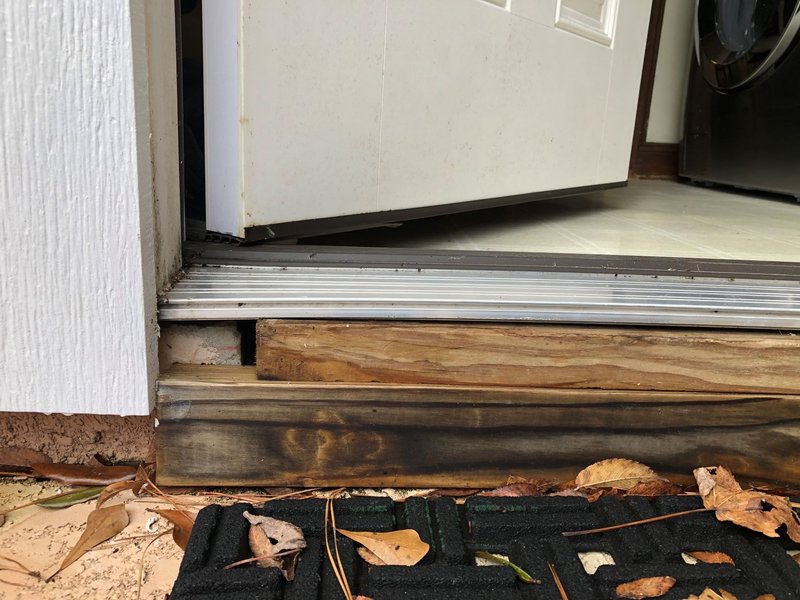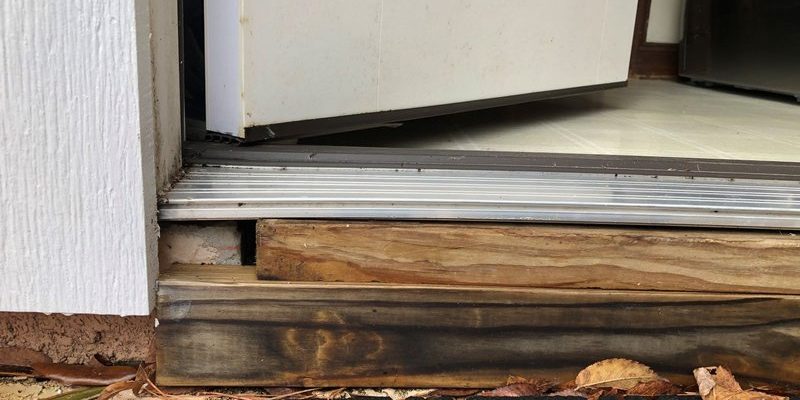
You might be wondering why this happens — and trust me, it’s rarely just one thing. Sometimes the threshold is too high or warped. Other times, the door itself has sagged, settled, or swelled. No matter the cause, a dragging door is both annoying and potentially damaging to your home. The good news? You don’t need to be a pro to dive into some basic troubleshooting. Let’s break down where to start, what to check, and how to fix a threshold that’s got your door scraping like it’s auditioning for a horror movie.
What Causes a Door to Drag on the Threshold?
Before reaching for your toolbox, it helps to know what you’re up against. The threshold is the raised strip at the bottom of your doorway. It’s there to keep out drafts, water, and dirt. But when your door starts dragging across it, something’s gone out of sync. Here’s the thing: the real culprit could be the threshold, the door, or even something in between — like the hinges or the frame.
A few common causes include:
- Threshold is too high: Over time, the threshold can swell, warp, or even be misinstalled from the start.
- Door has sagged: Hinges wear out, screws loosen, and before you know it, gravity is winning.
- Frame has shifted: Houses settle and move with the seasons, nudging your door frame out of shape.
- Weather stripping interference: Sometimes new or worn-out weather stripping under the door catches unexpectedly.
It’s usually not an exact science — more like detective work. If you spot shiny marks or scratches on the threshold, that’s your evidence. Take a minute to open and close the door while watching closely. Is it dragging everywhere, or just on a certain side? Don’t skip this step — it’ll make the rest of your troubleshooting much faster.
Checking the Door and Hinges First
Here’s a secret: even though the threshold looks like the problem, your door (and especially its hinges) are often the real troublemakers. Doors are heavy, and their hinges get a workout every day. Over time, the screws can loosen, or the hinges themselves can bend ever so slightly.
Let me explain what to look for:
- Loose screws: Grab a screwdriver and check every hinge. Tighten each screw — you’d be surprised how often this simple step lifts the door just enough to clear the threshold.
- Sagging or bent hinges: Look at the gap around the door. If the top is tight and the bottom drags, the door is sagging on its hinges. You might need to tighten, shim, or even replace a hinge if it’s really bent.
- Hinge wear: If the hinge pin is loose or wobbly, the door won’t hang straight. Swapping out old hinges for new ones can reset everything — like syncing your phone when it’s acting up.
Even if the threshold still looks high, check this step off first. Otherwise, you could lower the threshold and only mask a bigger issue, leading to more trouble down the road.
Inspecting the Threshold for Warping or Swelling
If the hinges look solid, it’s time to give the threshold some attention. Thresholds get a lot of abuse — water, dirt, and constant foot traffic. Over the years, wood thresholds can swell after rain, while aluminum or vinyl ones might warp from heat or shifting foundations.
Here’s how to spot problems:
- Visual check: Stand back and look — is the threshold even across its length? If one end is higher, that’s your trouble spot.
- Feel for bumps: Run your hand along the threshold. Any raised areas or “humps” are likely catching the bottom of your door.
- Check the fasteners: Nails or screws can work loose and stick up. Press them back down or replace them if they’re stripped.
You might find that the threshold just needs a reset. For wood thresholds, a sanding block can smooth down high spots. For vinyl or aluminum, tightening or replacing fasteners can bring things back to level. If it’s badly warped, replacing the threshold could be the best fix. It sounds intimidating, but honestly, it’s a straightforward job with the right tools.
Adjusting or Replacing Weather Stripping
Weather stripping is like the gasket on your fridge — it keeps outside air where it belongs. But sometimes, it can be part of the problem. If your weather stripping is too thick, misaligned, or falling off, it might add just enough height to drag the door.
Here’s how to check:
- Inspect condition: Look for torn, crumbling, or squished weather stripping. Even a little “fluff” in the wrong spot creates friction.
- Reposition or replace: If it’s loose, try to reseat it along the inside edge of the door or threshold. If it won’t fit, peel it off and bring a sample to your local hardware store for a match.
- Test before you finish: Close the door gently after any weather stripping adjustment to see if the drag is gone before nailing or screwing things in for good.
Like troubleshooting a remote that won’t sync or reset, sometimes it’s the smallest, sneakiest piece causing the trouble. Don’t overlook this step.
How to Lower or Adjust the Threshold Height
If you’ve checked the door, hinges, and weather stripping, but the problem’s still there — now it’s time to tackle the threshold itself. Some thresholds, especially newer ones, actually have *adjustable* screws hidden under little plugs or covers. These are there so you can raise or lower the threshold and get the perfect fit.
Here’s a basic step-by-step adjustment:
- Find the adjustment screws: Look for small plastic caps or covers along the top of the threshold. Pry them out gently with a flathead screwdriver.
- Lower the threshold: Turn the adjustment screw counterclockwise. Each turn lowers the threshold a small amount — go slow, and test the door often.
- Replace covers: Once things feel right, pop the covers back in place so dirt doesn’t get inside.
If your threshold isn’t adjustable, you can carefully sand or plane down raised wooden sections. For metal thresholds, sometimes loosening the screws and gently tapping the threshold with a rubber mallet can help. Just go slowly — it’s easier to take off a little than put any back!
If you ever feel like you’re making it worse, step back and reassess. Sometimes, the best troubleshooting is knowing when to call in a pro or check if a universal replacement fits better than wrangling with the old part.
When to Replace the Threshold Entirely
Sometimes, a threshold is beyond a quick fix. Maybe it’s rotted through, cracked, or has warped so badly that no amount of adjustment will stop the door from dragging. In these cases, replacing it is the way to go. It sounds like a big job, but it’s usually more about patience than skill.
Here’s how it generally goes:
- Remove the old threshold: Carefully pry it up with a flat bar. If it’s stuck, check for hidden screws or nails.
- Clean up: Scrape and vacuum the area so your new threshold sits flat and tight.
- Measure and cut: Bring the old threshold to the store if possible, or measure twice before cutting a replacement to length.
- Install the new threshold: Place it in, check the door swing, and anchor it down with screws.
If your door frame or sill is also damaged, consider calling a contractor. Sometimes, deeper issues (like leaks or settled foundations) cause those high spots in the first place, and a threshold swap alone won’t solve the problem long term.
Comparing Quick Fixes vs. Professional Repairs
It’s tempting to reach for the nearest sander or screwdriver and go to town when a door drags. And honestly, for most cases — tightening a few screws, sanding a small bump, or swapping weather stripping — that’s all it takes. But there are times when it makes sense to weigh your options.
DIY fixes work best when:
- The issue is minor and limited to a small area
- You’re comfortable using basic tools
- The door and threshold are otherwise in good shape
Call a pro if:
- The threshold is rotted, crumbling, or full of old termite tunnels
- The door frame is cracked, or the floor underneath feels spongy
- There’s been water damage or signs of foundation settling
Think of it like troubleshooting a stubborn remote: sometimes all you need to do is reset or pair it again; other times, you’re better off replacing it or calling for backup.
Preventing Future Problems With Door Thresholds
Fixing a dragging door feels great, but it’s even better when you don’t have to do it again anytime soon. A little maintenance now goes a long way. Here are some simple tips:
- Regularly check screws and hinges: Every few months, give those hinge screws a twist. Same goes for any threshold fasteners you can see.
- Keep things clean and dry: Sweep out dirt and wipe up water near the threshold — moisture is the enemy of both wood and metal.
- Update your weather stripping: If you notice drafts, cracked rubber, or gaps, swap it out before it can become a problem.
- Check after big weather changes: Doors and thresholds move with the seasons. If you notice dragging after a hot summer or rainy winter, check everything over again.
Think of this as syncing up your doors with the seasons, just like you’d check for low batteries in your remotes or run a reset. It’s basic, but it keeps annoying problems from sneaking up on you.
Wrapping Up: Keep That Door Gliding Smoothly
A threshold causing your door to drag can turn something simple — opening a door — into a daily struggle. But as you’ve seen, troubleshooting isn’t rocket science. Most of the time, it’s about checking the little things: loose screws, worn hinges, warped thresholds, or a sneaky strip of weather seal that’s out of place. Take your time, work in small steps, and test often. Before you know it, that door will swing open and shut with zero drama.
Whether you’re tightening a hinge, lowering a stubborn threshold, or considering a full replacement, solutions are out there — and most are well within reach for a handy homeowner. Keep an eye on things, do a little seasonal maintenance, and you’ll save yourself the headache (and that cringeworthy scraping sound) for good.
